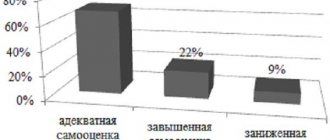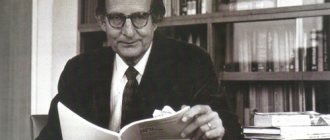The concepts of extraversion and introversion are known to everyone. But few people are familiar with the original meaning of these concepts. What Jung identified as a pathological tendency is now considered normal.
In modern psychology, extroversion and introversion are properties of temperament, which, in turn, are properties of the nervous system.
But in this article we will talk about these concepts as the role that people take on when they define themselves as an extrovert or an introvert.
Why are they (that is, we) doing this? There are many reasons: introversion as a fashion in a subculture, extroversion as a forced position in society, for example, if you need to engage in active sales or if your parents raised you in the spirit of “you need to be open, sociable and talkative.”
Decoding the concepts: introvert, extrovert and ambivert
There are several basic personality characteristics that make each of us unique. These include the concepts of introversion and extraversion, which were identified by the famous psychologist G. Jung.
In the accepted classification, there are three types of people: introverts, extroverts and ambiverts. What characterizes each type and what is the difference?
Who is an introvert
Introvert
is a person who is turned inward. This type of personality is immersed in their emotions, experiences and thoughts.
Introversion is understood as a person’s orientation towards himself. This concept implies the predominance of the individual’s inner world over interest in the surrounding reality and other people.
Who is an extrovert
Extrovert
- this is a person who directs his interests to the outside world, turns more to other people than to himself. Extroverts are communicative, optimistic people, dependent on communication.
Extraversion is the process of expressing feelings, emotions and thoughts outward. The concept presupposes the direction of the inner world into objective reality, the outpouring of the content of the personality to the outside.
Who is an ambivert
Ambivert
is a person who combines the qualities of introversion and extroversion. At certain moments, a person listens to himself, wants to be alone, to reflect.
Under other circumstances, a person strives for communication and self-expression. In psychology, it is believed that an ambivert is the most stable and stable personality type, since it manages to avoid the extremes inherent in the other two types.
In a pure state, extroverts and introverts are not so common. Usually we can only talk about dominant personality traits.
Introversion - Extraversion according to Jung
Carl Jung does not have a clear description of what an extrovert (extraversion) and an introvert (introversion) are. Carl Jung wrote about this more like a poet - in images and metaphors that are not reducible to clear formulations and criteria, and therefore in the works of different authors there are different interpretations of what Carl Gustav Jung meant.
According to one interpretation, Jung sets the direction of libido movement as the main criterion distinguishing extroverts and introverts. According to C. Jung, extraversion is manifested in the direction of a person’s libido (vital energy) towards the outside world, in the fact that the extrovert prefers social and practical aspects of life, operations with real external objects, and the introvert prefers immersion in the world of imagination and reflection. An extrovert is aimed at wasting his own energy, moving it towards surrounding objects, an introvert is aimed at accumulating, moving energy into the inner world.
An extrovert, according to Jung, is a type of personality (or behavior) that is oriented in its manifestations outward, towards others. Extroverts are characterized by behavior in which a person strives to communicate with people, attention from others, participation in public speaking, participation in crowded events and parties.
Extroverts are “charged” with energy from the outside world - from actions, people, places and things. They are energy wasters. Long periods of inactivity, inner contemplation, or loneliness, or communication with only one person deprive them of a sense of meaning in life. However, extroverts need to supplement the time they spend in action with intervals of just being, otherwise they will get lost in the whirlpool of frantic activity. Extroverts have a lot to offer our society: they express themselves easily, are focused on results, and love crowds and action.
Extroverts are like solar panels. For them, being alone or being inside is like being under heavy, dense clouds. Solar panels need the sun to recharge - extroverts need to be in public for this. An extrovert can be an excellent toastmaster, organizer (often on a voluntary basis), official, manager of people, artist or entertainer.
Over time, Jung significantly revised his views on extraversion-introversion. Firstly, he identified a number of independent factors (psychological functions), which he previously included in the composition of extraversion-introversion: thinking, feeling (experience), sensation, intuition. Secondly, starting with his programmatic work “Psychological Types” (1920), he spoke not about extroverts and introverts, but about extraversion or introversion of the dominant function. That is, he wrote that in the psyche of an individual a person can be dominated by one of the functions - extraverted or introverted thinking, feeling, sensing, intuition, while in the psyche there was also a place for other functions that played an auxiliary role or were repressed into the unconscious.
Below are reliable references from some of the works of Carl Jung.
"Psychological theory of types"
“My profession has long forced me to take into account the uniqueness of individuals, and the special circumstance that for many years—I know not how many—I have had to heal spouses and make man and woman mutually acceptable, further emphasizes the need to establish certain average truths. How many times have I had to say: “You see, your wife is a very active person and you really can’t expect her to live entirely in housework.” This is already a typification, and this expresses a kind of statistical truth. There are active and passive natures. However, this truism did not satisfy me. My next attempt was to assume that there is something like reflective and unthinking natures, for I saw that many natures that seem at first glance passive are in fact not so much passive as prudent. They first think about the situation - then they act, and since this is the usual way of action for them, they miss cases where direct action is necessary without thinking, and thus an opinion is formed about their passivity. Those who, without thinking, jump into a situation with both feet, only to realize later that they seem to have landed in a swamp, have always seemed to me unthinking. Thus, perhaps, they could be described as unthinking, which was appropriately manifested in activity; the foresight of others in a number of cases is ultimately a very important activity and a very responsible action in comparison with the thoughtless fleeting flash of mere efficiency. However, I very soon discovered that indecision is not always caused by forethought, but rather that action is not always thoughtless. The indecisiveness of the first is just as often based on his characteristic timidity, or at least on something like a habitual retreat in the face of too difficult a task, and the direct activity of the second is often determined by greater trust in the object than in himself. This observation prompts me to formulate the typification as follows: there is a whole class of people who, at the moment of reaction to a given situation, seem to distance themselves, quietly saying “no”, and only then react, and there are people belonging to another class who, in such a way, they react directly to situations, apparently being in full confidence that their action is undoubtedly correct. That is, the first class is characterized by some negative attitude towards the object, the last - rather positive. As you know, the first class corresponds to an introverted attitude, and the last one to an extroverted attitude.”
"Psychological typology"
Extraversion is characterized by interest in an external object, responsiveness and readiness to perceive external events, a desire to influence and be influenced by events, a need to interact with the outside world, the ability to tolerate turmoil and noise of any kind, and in fact find pleasure in it, the ability to maintain constant attention to the world around us, making many friends and acquaintances without much consideration, however, and ultimately with the presence of a feeling of great importance to be close to someone chosen, and therefore a strong tendency to demonstrate oneself. Accordingly, the life philosophy of an extrovert and his ethics carry, as a rule, a highly collectivistic nature (beginning) with a strong tendency towards altruism. His conscience depends largely on public opinion. Moral concerns arise primarily when “other people know.” The religious beliefs of such a person are determined, so to speak, by a majority vote.
The actual subject, the extrovert as a subjective being, is - as far as possible - immersed in darkness. He hides his subjective beginning from himself under the cover of the unconscious. The reluctance to subject one's own motives and impulses to critical reflection is very clear. He has no secrets, he cannot keep them for long, since he shares everything with others. If something that cannot be mentioned touches him, such a person will prefer to forget it. Anything that could dim the parade of optimism and positivism is avoided. Whatever he was thinking about, doing or intending to do is presented convincingly and warmly.
The mental life of a given personal type plays out, so to speak, outside of himself, in the environment. He lives in others and through others - any reflection on himself makes him shudder. The dangers lurking there are best overcome by noise. If he has a “complex”, he takes refuge in social circles, turmoil and allows himself to be assured several times a day that everything is in order. If he does not interfere too much in other people's affairs, is not too pushy and not too superficial, he can be a distinctly useful member of any community.
In this short article I have to content myself with a quick sketch. I simply intend to give the reader some idea of what extraversion is, something he can bring into line with his own knowledge of human nature. I deliberately began with a description of extraversion, since this attitude is familiar to everyone - the extrovert not only lives in this attitude, but also demonstrates it in every possible way in front of his comrades out of principle. In addition, such an attitude is consistent with certain generally accepted ideals and moral principles.
Introversion, on the other hand, directed not at the object, but at the subject and not oriented by the object, is not so easy to observe. An introvert is not so accessible; he seems to be in constant retreat in front of the object, giving in to it. He keeps his distance from external events without interacting with them, and exhibits a distinctly negative attitude towards society as soon as he finds himself among a fair number of people. In large companies he feels lonely and lost. The thicker the crowd, the stronger his resistance grows. At least he is not “with her” and has no love for gatherings of enthusiasts. He cannot be classified as a sociable person. What he does, he does in his own way, shielding himself from outside influences. Such a person tends to look awkward, clumsy, often deliberately reserved, and it just so happens that either due to some unceremoniousness of manner, or because of his gloomy inaccessibility, or something completely inappropriate, he unwittingly offends people. He reserves his best qualities for himself and generally does everything possible to keep silent about them. He easily becomes distrustful, self-willed, often suffers from the inferiority of his feelings and for this reason is also envious. His ability to comprehend an object is not due to fear, but because the object seems to him negative, demanding attention, irresistible or even threatening. Therefore, he suspects everyone of “all mortal sins”, he is always afraid of being made a fool, so he usually turns out to be very touchy and irritable. He surrounds himself with the barbed wire of difficulties so tightly and impenetrably that in the end he himself prefers to do something rather than sit inside. He confronts the world with a carefully developed defensive system, composed of scrupulousness, pedantry, moderation and frugality, foresight, “high-lipped” correctness and honesty, painful conscientiousness, politeness and open distrust. There are few rosy colors in his picture of the world, since he is hypercritical and will find a hair in any soup. Normally, he is pessimistic and worried because the world and human beings are not one bit kind and seek to crush him, so he never feels accepted or cared for by them. But he himself also does not accept this world, at least not completely, not completely, since first everything must be comprehended and discussed by him according to his own critical standards. Ultimately, only those things are accepted from which, for various subjective reasons, he can derive his own benefit.
For him, any thoughts and reflections about himself are a real pleasure. His own world is a safe haven, a carefully tended and fenced garden, closed to the public and hidden from prying eyes. The best thing is to have your own company. He feels at home in his world, and any changes in it are made only by himself. His best work is done using his own resources, on his own initiative and in his own way. If he succeeds after a long and exhausting struggle to assimilate something alien to him, then he is able to achieve excellent results. The crowd, the majority of views and opinions, public rumor, general enthusiasm will never convince him of anything, but rather will force him to hide even deeper in his shell.
His relationships with other people become warmer only in conditions of guaranteed security, when he can put aside his defensive mistrust. Since this happens to him infrequently, the number of his friends and acquaintances is accordingly very limited. So the mental life of this type is entirely played out internally. And if difficulties and conflicts arise there, then all the doors and windows turn out to be tightly closed. The introvert withdraws into himself along with his complexes until he ends up in complete isolation.
Despite all these characteristics, an introvert is by no means a social loss. His withdrawal into himself does not represent a final renunciation of the world, but a search for tranquility in which solitude enables him to make his contribution to the life of the community. This type of personality is the victim of numerous misunderstandings - not because of injustice, but because he himself causes them. He also cannot be free from accusations of receiving secret pleasure from a hoax, because such a misunderstanding brings him a certain satisfaction, since it confirms his pessimistic point of view. From all this it is not difficult to understand why he is accused of coldness, pride, stubbornness, selfishness, complacency and vanity, capriciousness, and why he is constantly admonished that devotion to the public interest, sociability, imperturbable refinement and selfless trust in powerful authority are the true virtues and indicate a healthy and energetic life.
The introvert fully understands and recognizes the existence of the above-mentioned virtues and admits that somewhere, perhaps, just not in the circle of his acquaintances, there are beautiful, spiritual people who enjoy the undiluted possession of these ideal qualities. But self-criticism and awareness of his own motives quickly disabuse him of his capacity for such virtues, and his incredulous, keen gaze, sharpened by anxiety, allows him to constantly discover in his comrades and fellow citizens donkey ears sticking out from under a lion's mane. Both the world and people are troublemakers and a source of danger for him, without providing him with an appropriate standard by which he could ultimately navigate. The only thing that is indisputably true for him is his subjective world, which - as sometimes, in moments of social hallucinations, appears to him - is objective. It would be very easy to accuse such people of the worst kind of subjectivism and unhealthy individualism, if we were beyond any doubt about the existence of only one objective world. But such a truth, if it exists, is not an axiom - it is only half the truth, the other half is that the world also exists in the form in which it is seen by people, and ultimately by the individual. No world simply exists without an insightful subject who learns about it. The latter, no matter how small and inconspicuous it may seem, is always another pillar supporting the entire bridge of the phenomenal world. The attraction to the subject therefore has the same validity as the attraction to the so-called objective world, since this world is based on psychic reality itself. But at the same time, this is a reality with its own specific laws, which are not derivative or secondary in nature.
The two attitudes, extraversion and introversion, are opposite forms that have made themselves known to no lesser extent in the history of human thought. The problems they raised were largely foreseen by Friedrich Schiller and form the basis of his Letters on Aesthetic Education. But since the concept of the unconscious was not yet known to him, Schiller was unable to achieve a satisfactory solution. But, in addition, philosophers, who were much better equipped in terms of deeper progress in this matter, did not want to subordinate their thinking function to thorough psychological criticism and therefore remained aloof from such discussions. It should be clear, however, that the internal polarity of such an attitude has a very strong influence on the philosopher's own point of view.
For an extrovert, an object is interesting and attractive a priori, just like a subject or mental reality for an introvert. We might therefore use the expression "numerical emphasis" for this fact, by which I mean that for the extravert the quality of positive meaning, importance and value is attached primarily to the object, so that the object plays a dominant, determining and decisive role in all mental processes from the very beginning, just as the subject does for the introvert.
More details See→
"Psychological types"
In my practical medical practice with nervous patients, I have long noticed that in addition to many individual differences in the human psyche, there is also a typical development, and above all two sharply different types, which I called the type of introversion and the type of extroversion.
Every person has both mechanisms, extraversion and introversion, and only the relative preponderance of one or the other determines the type. Despite the difference in formulations, a commonality in the basic understanding is always noticed, namely the movement of interest towards the object in one case and the movement of interest from the object to the subject and to his own mental processes in another case. In the first case, the object acts on the subject's tendencies like a magnet, it attracts them and largely conditions the subject; it even so alienates the subject from itself, so changes its qualities in the sense of equating it with the object, that one might think that the object has greater and ultimately decisive significance for the subject, as if the complete subordination of the subject to the object is to a certain extent an absolute predestination and a special meaning life of destiny. In the second case, on the contrary, the subject is and remains the center of all interests. We can say that it seems as if all vital energy is directed towards the subject and therefore always prevents the object from acquiring any influence on the subject. It seems as if energy is moving away from the object, as if the subject is a magnet that wants to attract the object to itself.
The most generally introverted point of view could be designated as one that, under all circumstances, tries to place the personality and the subjective psychological phenomenon above the object and the objective phenomenon, or at least to affirm them in relation to the object. This attitude therefore gives greater value to the subject than to the object. Accordingly, the object is always at a lower level of value, it is of secondary importance, it is sometimes only an external objective sign of subjective content, as if the embodiment of an idea, and, however, it is the idea that is essential; or it is an object of emotion, and, however, the most important thing is an emotional experience, and not an object in its real individuality. The extraverted point of view, on the contrary, places the subject below the object, with the object having the predominant value. The subject is always of secondary importance; the subjective phenomenon sometimes seems only to be a disturbing and unnecessary appendage to what is happening objectively. It is clear that psychology proceeding from these opposing points of view must split into two completely different orientations. One views everything from the angle of its understanding, and the other from the angle of what is happening objectively.
These opposing attitudes are, first of all, only opposing mechanisms: diastolic movement towards the object and perception of the object, systolic concentration and separation of energy from the perceived object. Each person possesses both mechanisms, as an expression of his natural life rhythm, which Goethe, of course, not by chance designated by physiological concepts characterizing the activity of the heart. The rhythmic change of both forms of mental activity should correspond to the normal course of life. The complex external conditions under which we live, and, perhaps, the even more complex conditions of our individual mental predisposition, however, rarely allow the course of mental activity to be completely undisturbed. External circumstances and internal predisposition very often favor one mechanism and limit and hinder another. This naturally leads to the preponderance of one mechanism. If this condition somehow becomes chronic, then as a result of this a type arises, that is, a habitual attitude in which one mechanism constantly dominates, without being, of course, able to completely suppress the other, since it necessarily belongs to mental activity life. Therefore, a pure type can never exist in the sense that it has complete control of one mechanism while the other is completely atrophied. A typical setup always means only the relative preponderance of one mechanism.
Characteristics of an introvert
It’s easy enough to recognize an introvert in any company. He can sit all evening with a glass of wine and contemplate what is happening around him, thinking about something of his own.
Such people rarely show their emotions; they are reserved and taciturn. Introverts give the impression of being calm people, but this is not entirely true. They are not used to venting their inner feelings on others. Introverts are more interested in understanding their experiences alone.
Positive traits of introversion include
:
- Independence from other people's opinions. An introvert's own value system is strong and unshakable. He is confident in his judgment and will not change his principles to please others.
- Stable external reactions. You can be sure that in the heat of a quarrel an introvert will not splash hot tea in his face.
- Thoughtfulness, perseverance, ability to take responsibility. An introvert often reflects, so he knows his strengths and weaknesses; he seeks support within himself, without appealing to others.
Introverts also have their disadvantages that hinder progress towards success.
:
- High level of sensitivity and self-criticism. The personality is prone to deep introspection and self-criticism, which adversely affects the psyche.
- Restraint of emotions, which can lead to psychosomatics. There are feelings that cannot be kept to yourself.
- Inability to make the right contacts, poor communication skills. An introvert has difficulty getting along with people and does not know how to ask for help. It is difficult for a person to build social relationships; she is indifferent to the opinions of other people. Negative traits hinder career development and adaptation in a changing external environment.
Characteristics of an extrovert
An extrovert strives for publicity; he needs to participate in public events where there are large crowds of people. Such a person always strives to be the center of attention. At the party, we immediately recognize him: he actively communicates with all the guests, comes up with competitions and fun, and pulls us by the hand to dance.
All the energy of an extrovert goes outside, while an introvert tends to accumulate it. On the other hand, energy reserves are replenished through active communication with others. An extrovert can be easily identified by his direct gaze; in dialogue, he always looks into the eyes of his interlocutor.
The benefits of extraversion include:
:
- Openness and sociability. An extrovert will tell you everything about himself and will be happy to listen to your problems.
- Optimism and good nature. A person is always ready to help and is attentive to the needs of loved ones. He is not prone to judgment and moralizing.
- Active, wide range of interests. You will rarely find an extrovert at home on the couch. He is directed towards the outside world: today - a swimming pool, tomorrow - a cat show.
- A large number of friends and acquaintances, which helps in career advancement and business.
There are also negative aspects
:
- An extrovert literally wastes energy; without proper return, he can feel empty and lack of strength.
- During times of forced loneliness, a person cannot concentrate on himself and becomes depressed. It seems to him that “life is passing by.”
- Strong dependence on the opinions of other people.
- Expressed extroverts cannot be and live alone; if fate puts them in this position, then isolation becomes a problem. A person cannot even sleep in an empty apartment.
Sometimes extroverts give the impression of being superficial and frivolous people, incapable of introspection, which is not always true. An extrovert with a healthy psyche is quite capable of studying and adjusting his strengths and weaknesses.
Characteristics of an ambivert
Ambiversion involves a combination of the two personality types described above. Depending on the circumstances, a person is an extrovert or an introvert.
An ambivert can easily join any social group if necessary. However, he will not show that assertiveness and obsession inherent in an extrovert. A person listens to the emotions of others and tries not to offend, which distinguishes him from an introvert who is immersed only in his own experiences.
An ambivert's personality is open to communication, but he also knows how to listen without interrupting or making comments. Therefore, an ambivert has many acquaintances and has established long-term interpersonal contacts.
An ambivert can work independently or in a team with equal ease. For an extrovert, hard, monotonous work is always a burden; participation in a common cause is more important to him. An introvert, on the contrary, prefers to work alone, when no one distracts from the process.
These people are very flexible and adaptable. They subconsciously understand when to be active and when to remain silent. They always try to find a way out of difficult stories, without splashing out emotions like extroverts, but also without withdrawing into themselves like introverts.
Relationship between extraversion and EEG indicators
The problem of extraversion and its connection with the character of the EEG is a particular one; in general, it is a problem of the relationship between psychological characteristics and physiological indicators. The concepts of extraversion and introversion are understood somewhat differently in different theories, and therefore the explanation of their physiological basis also differs. G. Eysenck put forward a hypothesis according to which extroverts are characterized by a high level of rapidly developing reactive inhibition, while the development of the inhibition process in introverts occurs more slowly. In later studies, the formulation of this hypothesis has undergone some changes. According to Hal's theory, the accumulation of inhibition during intense activity invariably leads to the emergence of "blocks", the strengthening of reactive inhibition, which is understood as negative reinforcement, gradually brings negative reinforcement to level D, general positive reinforcement, under which conditions the dissipation of inhibition should be blocked. When reactive inhibition is sufficiently dissipated, activity begins again and continues until inhibition again reaches point D. Later, Eysenck put forward a theory, the essence of which is expressed as follows: individual differences in extraversion-introversion are due to the work of the ascending reticular activating system (ARAS) . This system is thought to mediate cortical activation in response to external stimulation, and our theory is that under conditions of identical stimulation, extroverts will experience greater activation than introverts. The reticular formation serves as an intermediate link for cortical inhibition, which suggests that inhibition most likely develops much faster in extroverts than in introverts. A similar problem about the connection between extraversion, as one of the components of temperament and EEG indicators, was posed in Russian psychology at the school of V.D. Nebylitsyna. Nebylitsyn, considering such a connection, refers to the works of Western and domestic researchers showing the connection between these indicators. Thus, analyzing such a background indicator as the maximum amplitude of the alpha rhythm, he writes:
“A number of authors are trying to outline some parallels of this indicator with manifestations of temperament and personality behavior. L. Saul, H. Davis and P. Davis associate high amplitude with passivity and a tendency to avoid responsibility and effort, and low amplitude with the opposite qualities. A. Gastaut and others characterize individuals with high-voltage alpha-ri, and with low-voltage alpha-ri as hypersensitive, hyperemotional, hyperactive” (V.D. Nebylitsyn, p. 66).
“It is known that I.P. Pavlov initially associated hysteria with the predominance of inhibition, and neurasthenia with the predominance of excitation. As noted by V.D. Nebylitsin (1966), this is a rather bold solution to the issue, since the presence of a predominance of one of the processes in pathology does not mean that normally this patient has the same relationship between excitation and inhibition” (E.P. Ilyin, p. 161).
In contrast to Eysenck's theory E.P. Ilyin cites works in which the feedback can be traced: A. Mundy-Castle, citing data from P. Davis, obtained a significant correlation between the frequency of the alpha rhythm and temperament indicators: persons with a relatively higher frequency (more than 10 counts / sec) have a tendency to sharp , impulsive, unstable response, and those with less frequency - to a pattern of behavior that can be characterized as more depressive. At the moment, the problem has not been completely resolved and is under development.
Studies that have examined the relationship between EEG and extraversion-introversion
Table 2. Data according to Eysenck [1].
| Author | Personality Research Toolkit | EEG indicators | results |
| Gottlober (1938) | Subjective Assessment and Nebraska Personality Inventory (NPI) | 30 sec; eyes closed; alpha rhythm indicator (alpha index); manual evaluation | Extroverts have a higher alpha index than introverts |
| Henry and Knott (1941) | NPI | 300 sec; eyes closed; alpha index, i.e. 50% alpha – “high” alpha index; 8-12 Hz and 7 microvolts; manual evaluation | Introverts have a higher alpha index (not significant) |
| Nebylitsyn (1963) | Predominance of excitation or inhibition (by number of tasks) | Origin unknown; alpha, beta and theta index, amplitude and frequency | Namely: with a predominance of inhibition, it is characterized by a high alpha index and amplitude, but a low frequency of the alpha rhythm; high level of beta rhythm (amplitude, index and frequency) and frequency of theta rhythm. This group of traits probably corresponds to extraversion (Gray, 1967). |
| Savage (1964) | Maudsley Personality Inventory (MPI) | 240 sec.; eyes closed; low frequency; low-frequency analysis of 8-13 Hz filter; "amplitude" of the alpha rhythm with open eyes and 10 min. with eyes closed, theta, alpha, beta. | Extroverts are characterized by a large amplitude. Link to neuroticism |
| Glass and Broadhurst (1966) | MPI or EPI | Duration unknown; measured in the process of problem solving (arithmetic operations, Glass, 1964). | Extraversion is negatively correlated with rcp and alpha index |
| Marton and Urban (1966) | Information is absent | Alpha index and alpha frequency; method of obtaining is unknown | Extroverts are characterized by a higher index and lower frequency |
| Fenton and Scotton (1967) | MPI | 30 sec; eyes closed, alpha index, average amplitude, 8-13 Hz and 15 microvolts, manual estimation | Negative (but not significant) correlation between extraversion and index and frequency |
| Hume (1968) | EPI | Duration unknown; alpha; manual evaluation of belt filter performance | Alpha index and extraversion have a positive loading on the same factor |
| Gayle, Coles and Blaydon | EPI | 110 sec., eyes closed, 2-20 Hz divided into 9 frequencies; low-frequency analysis gives the average integrated and average dominant frequency (s.f.f.) 10 min. | Extroverts have higher integrated across all frequencies and higher integrated across alpha, beta and theta rhythms with both eyes open and closed. |
Table 3. Data according to Nebylitsyn [11].
| Author | Characteristics of behavior | EEG indicators |
| A. Gastaut | Hypoexcitability syndrome | High-amplitude, continuous alpha rhythm, 8-9 counts/sec. |
| G. Eyer, G. Lelor, M. Agathon | Great reactivity | Long duration of alpha blockade |
| L. Saul, H. Davis, P. Davis | Activity | Low alpha amplitude |
| A. Mundy Castle | Tendency to react sharply, impulsively and unsustainably | High alpha frequency |
If we make an assumption by comparing the characteristics of temperament with those characteristic of extroverts or introverts, we will obtain the following data (taken from [1], [8] and [11]):
Table 4. Background EEG indicators and degree of extraversion (table by A.V. Maslennikova).
| Indicators | Extraversion | Introversion |
| High alpha frequency | 3 | 3 |
| High alpha index | 4 | 2 |
| High alpha amplitude | 1 | 3 |
| High duration of depression | 1 | no data |
From the data in Table 3 it is clear that based on the indicators of frequency, index, amplitude and duration of depression of the alpha rhythm, one cannot unambiguously decide in favor of Eysenck’s theory of the interdependence of activation of the cerebral cortex and extraversion. We can only say that most likely extraversion is observed at a low amplitude of the alpha rhythm. For other indicators, based on the results of the table, it is difficult to make any assumption regarding the dependence of the variables under consideration. In the study by A.V. Mironycheva made an attempt to understand the current state of the problem and test the hypothesis about the existence of any connection between EEG characteristics and the degree of human extraversion. The results obtained showed the ambiguous nature of the dependence. In general, we can talk about differences in background indicators between extroverts and introverts. Alpha and beta rhythms are higher in extroverts than in introverts. With regard to the characteristics of SVP in extroverts and introverts, the relationship is ambiguous.
How to understand whether I am an introvert, an extrovert or an ambivert
To understand what type of personality you are, we suggest that you familiarize yourself with the characteristic features of each of them in a concentrated form.
| Personality type | Dominant characteristics |
| Introvert | Does not strive to get into noisy companies and public events. It is difficult and long to experience failures and setbacks. He speaks little and listens a lot. Lives in the world of his fantasies. Holds back emotions. Likes to philosophize. Gets attached forever, knows how to remain faithful. Has patience. Meticulous, observant, focuses on details. |
| Extrovert | Strives to make new acquaintances. Easy to climb. Sociable, talkative. Emotional. Everything that's inside instantly spills out. He puts himself on display and dreams of being the center of attention. Can't stand loneliness. Focuses on the opinions of others. |
| Ambivert | He understands the mood of other people well and is intuitive. Equally psychologically stable alone and in company. The choice is always made based on one’s own feelings. Able to adapt to external conditions. Depending on the situation, he becomes a participant or an observer. Expresses emotions in adequate doses, does not keep them to himself, but does not become hysterical. |
If you have any doubts about your affiliation, we suggest you take a short test.
Answer only “yes” or “no” to the following questions and statements.
:
- Do you need new places or people to be happy?
- Do you easily give up on original plans?
- Do you need the support of loved ones to make a decision?
- Does your excitement often give way to low mood?
- Do you act first and think later?
- Can you bet on anything when you're excited?
- Do you like to talk about yourself and your emotions?
- You don’t know what melancholy and melancholy are.
- Do you meet the opposite sex without false modesty?
- You don't worry about what you might have said or done inappropriately.
- Do you not return your thoughts to this or that task if it has already been done?
- You prefer not to dream, but to act.
- When choosing between reading a book and going to a party, you will choose the party.
- Are you like a fish in water in a big company?
- Do you like it when everyone's eyes turn to you?
- You do not know the feeling of guilt and remorse.
- You cannot stand monotonous routine activities.
- You love meetings where people joke with each other.
- You talk a lot and with pleasure.
- Your sleep is sound, no thoughts can interrupt it.
Let's start counting the results. If you answered yes to 10 or more questions, then your type is “extroverted.” The more “yes” answers, the more pronounced the typical characteristics of an extrovert are in a person. Think about whether you should learn to understand yourself and listen to your inner voice?
If there are less than 10 positive statements, you are an “introvert.” Is your number of “yes” approaching zero? Then introversion can become a problem. Ask a close friend to describe you from the outside. Most likely you have a gloomy appearance and drooping shoulders.
If the answers “yes” and “no” are approximately equal, congratulations, you are an ambivert. This is the most stable type that achieves the greatest success.
Flexibility is key
It is important for HR managers and executives to take into account the personality types of employees in order to assign them those projects in which they will show their best sides, and not vice versa. For example, if you want an extrovert to do a great job at a task, you shouldn't give him a task that requires a lot of attention to detail.
Encourage introverts to be active when they show it, and make sure that there are not too many extroverts and that they do not irritate their colleagues.
But most importantly, remember that there are very few people who are extroverted or introverted. So don’t prioritize what type you or your colleagues are, but flexibility and mutual respect.
How can an introvert change his personality traits and become an extrovert?
First you need to answer the question: “Do I need to become an extrovert?” After all, the opposite type has many disadvantages that we mentioned. If a person is comfortable with an introverted existence, then there is no need to change anything.
When introversion has become a problem and a person has literally withdrawn into his experiences, you can work on the skills of an extrovert. It is problematic to do this on your own, since changing types is subject to adjustment with great difficulty. It's better to see a psychologist.
You can help yourself if you start listening more to what other people say. Try to overcome the desire to delve into yourself, look at the world around you, notice everything interesting and useful in it.
Don't hide your emotions, express them outside. If you are angry - show it, if you are happy - dance or sing. Discuss your feelings with people. Don't be afraid to look on the bad side. By and large, we are all similar to each other and experience the same emotions.
Go out into public, attend public events. Don't be shy about people, meet people, communicate more. You come to an exhibition - discuss new paintings with a random visitor, work out in the gym - ask your neighbor how he achieved such outstanding results.
Over time, extroverted skills will become a habit, and you will not feel awkward or displeased from communication.
Links and literature
1.Eysenck G.Yu. Personality structure. M.: KSP+; St. Petersburg: Yuventa, 1999.
2. Eysenck G.Yu., Wilson G. How to measure personality. M.: Cogito-Center, 2000.
3.Ananyev B.G. Man as an object of knowledge. L., 1968.
4. Anastasi A. Psychology of individual differences: texts - M., 1982.
5. Wundt V. Soul and brain. St. Petersburg, 1901.
6. Danilova N.N. Psychophysiology. Uch. for universities. M.: Publishing house Aspect-Press, 2001.
7.Drobnitsa I.P. Theoretical model of extraversion-introversion
7.Ivanov E.M. The problem of searching for the substrate of subjective reality. B\m, 1993.
8. Ilyin E.P. Differential psychophysiology – 2nd ed., add. – St. Petersburg: Peter, 2001.
9. Maryutina T.M., Ermolaev O.Yu. Psychophysiology, teaching. allowance. M.: publishing house YuRAO, 1998.
10. Morin E. Spirit and brain // Modern science: human knowledge. – M.: Nauka, 1988.
11. Nebylitsyn V.D. Psychophysiological studies of individual differences. M.: Nauka, 1976.
12. Sokolov E.N. Theoretical psychophysiology. M.: Moscow State University Publishing House, 1986.
13. Jung K.G. Psychological types. St. Petersburg: Yuventa, M.: Progress - Univers, 1995.









